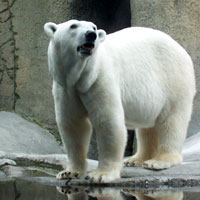
| Polar Bears Starving to Death in Hudson Bay | 14 December 10 |
 Dramatic new video footage shows the dire consequences of climate inaction for polar bears. The video, shot on November 23, 2010 on the western shores of Hudson Bay in Manitoba, Canada, shows an undernourished polar bear mother and her two starving cubs struggling to survive. One of the cubs experiences seizures in the video, and both cubs died within two days of the filming.
Dramatic new video footage shows the dire consequences of climate inaction for polar bears. The video, shot on November 23, 2010 on the western shores of Hudson Bay in Manitoba, Canada, shows an undernourished polar bear mother and her two starving cubs struggling to survive. One of the cubs experiences seizures in the video, and both cubs died within two days of the filming."Such events can only become more frequent in the future because increased greenhouse gas levels guarantee that the climate will continue to warm, and a warmer world means less sea ice-in Hudson Bay and elsewhere. Scientists have projected that polar bears could disappear entirely by the end of the century if greenhouse gas emissions are not reduced," said Dr. Steven Amstrup, Polar Bear International's senior scientist. Polar bears are completely dependent upon large expanses of sea ice to hunt, feed and survive. They use the sea ice as a platform to capture seals and other prey. Polar bears in western Hudson Bay must come to land each spring when the sea ice melts. While onshore the bears fast until the ice freezes again losing up to 30 percent of their body mass. Twenty years ago, the average date the bears returned to the ice was November 8. A decade ago that date stretched to November 20. In 2009 the bears returned to the ice on approximately December 4, and in 2010 the bears begun to return to the ice around December 7. The western Hudson Bay polar bear population declined 22 percent between 1987 and 2004. If current trends persist it will likely be the first polar bear population driven extinct by global warming. Watch Nature Exposures video Mother Polar Bear Loses Her Two One Year Old Cubs Most Likely to StarvationView December 7, 2010 Polar Bears International press release (PDF) View December 8, 2010 Center for Biological Diversity press release View December 8, 2010 Common Dreams article Source: Polar Bear International, Center for Biological Diversity |
|
 Print version Print version |
Top |
